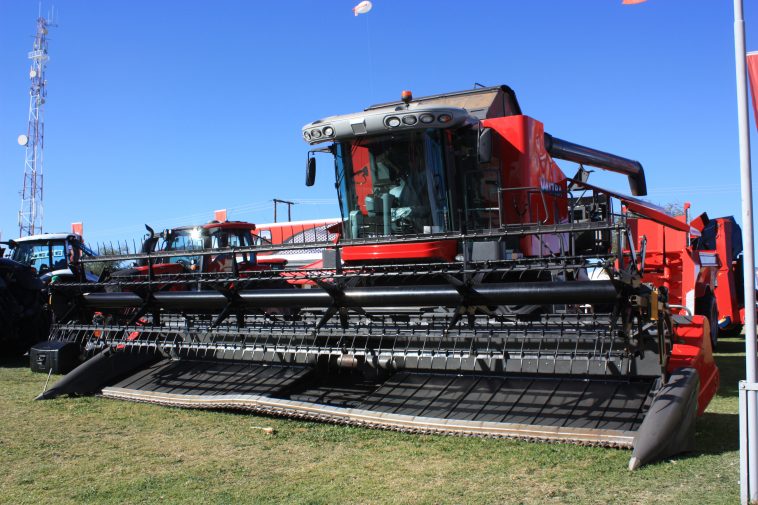Everyone wants to drive a Ferrari, but if your farm road does not allow it, it does not help investing in such a luxury. The same principle applies to a combine harvester. Hansie Theart from Coligny says his long-term maize yield is on average 4,4 t/ha. If he is to try one of the new super big and fast combines entering the country, the harvester will never be filled to capacity and the threshing will not be effective.
To fully utilise the capacity of a large machine you must increase your working speed and use a wider header. Hansie says the problem with increasing working speed is that you also increase the risk of driving through holes and damaging the machine.
By increasing the width of the header, you also increase your cost and it may contribute to additional wear and tear on the machine.
Therefore, he is impressed with the new Valtra BC5800 introduced at NAMPO this year. The combine has already proven its harvesting capabilities on several farms. “It is only the price that will determine whether I will invest in the machine or not,” he says.
Wynn Dedwith from Valtrac says affordability is one of the reasons why they started looking at a smaller combine, especially keeping the dryland farmers in the western regions of the country in mind. He says the principle is that your harvest should pay for your harvester.
“Many farmers have smaller, but aging combines, and we believe it is time that they also benefit from new technology to suit their circumstances,” he says. Not everyone can fully utilise a Class 6, 7 or 8 combine harvester and in the end profitability will suffer.
“We believe there is room for a smaller, new combine harvester bringing new technology, simplicity, reliability and lower fuel consumption to the table.”
Hansie and Nardus Steyn, on whose farm the combine has been tested, were both surprised by the capacity of the Class 5 combine. Nardus claims that even at 9 km/h in a field with 6 tonne/ha potential, the field was harvested cleanly and with minimal wastage.
Hansie says: “I was telling the driver he was messing around working so fast, but when I got out and looked behind the machine I was surprised at the quality of the work.”
Nardus agrees: “It is a no-nonsense machine, it harvests clean, has excellent capacity and the fuel consumption looks good.”
According to Wynn fuel tests have shown that the Valtra BC5800 uses up to a third less fuel compared to other Class 5 combines. Valtra is part of the AGCO group and as the reliable Valtra tractors, the combines are driven by AGCO Power engines, boasting award winning technology in power output and fuel efficiency.

Effective, simplistic technology
The combine is described as a hybrid (Valtra Hybrid BC5800). Cattle farmers will relate to the term hybrid in describing the heterosis gained when crossing two successful breeds. The hybrid has a conventional rotating threshing drum in front, but instead of straw walkers two 3,5 metre X 470 mm axial flow drums provide a separation area of 10,2 m2.
Wynn says: “It is a machine with fewer moving parts and everything is open and accessible. What you see is what you get.”
The combine was designed in Brazil for maize, soya beans and rice. Any combine capable of handling tough rice can handle all crops in Africa!
Wheat offers no challenge and with growing soya bean production in Africa, farmers can look forward to the ideal soya bean harvesting partner. Valtra has its own 7,6 metre (25 feet) flex draper perfect for the cleanest possible pickup of wheat and soy bean.
A header plays a very important role in picking up soya beans, but the hybrid threshing action of the combine itself also contributes to improved yields and the sensitive handling of beans.
Any standard header will fit on the combine, but Valtrac will also provide an 8 row 900 mm maize head.
Wynn says: “The combine can handle up to a 13 row 500 mm head, but we foresee that most of the farmers in the region will deploy their combines with 6 or 8 row headers.
Regarding precision technology, a farmer can choose whether he wants to use the combine on its most basic level or scale up to the most advanced technology allowing him to sit in his office remotely following his yield results on his smart phone while compiling his precision charts. The combines are GPS ready and can be adapted for auto steer.
A farmer can order his machine for the level on which he wants to operate.

Good service and support
“Five years ago, I would never have considered entering the competitive combine harvester market in Southern Africa,” says Wynn. What has changed in the meantime, is the clear need for reliable new technology in the Class 5 combine category and the establishment of the huge AGCO parts facility near the OR Tambo Airport in Johannesburg.
This depot supplies the whole Africa and South Asia-Pacific region. That means Valtrac has easy access to all the necessary parts without having to keep the full range in stock at all the Valtrac premises. Wearing parts are always available at all the Valtra offices, and as in the case of all Valtrac’s products, farmers can rely on the legendary service of this 21-year-old family enterprise.
Hansie says all the tractors on his farm are Valtra, and he knows Valtrac supply reliable equipment supported by excellent service. He expects nothing less of the combine.
For more information on the combine harvester or to order your Valtra Hybrid BC5800 for the next harvesting season, contact Attie de Villiers on +27(0)83-261-9863, +27(0)56-817-7308 or attiedev@valtrac.co.za. On Valtrac’s website www.valtrac.co.za you can also find information on their complete range of tractors and implements.


